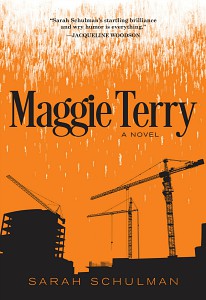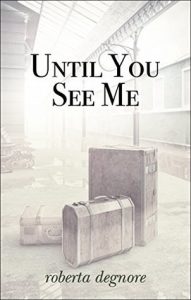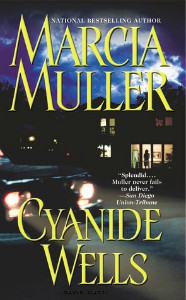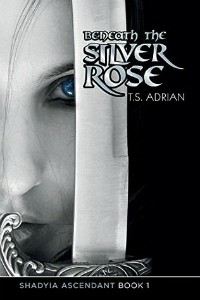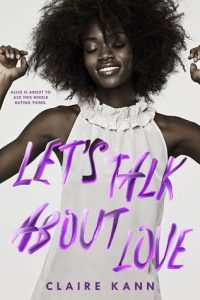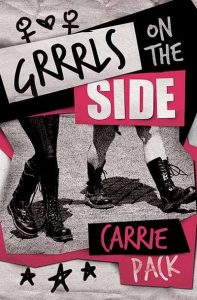“Everyone was in a state of confusion because the president was insane.”
–Maggie Terry by Sarah Schulman
Maggie Terry is longtime lesbian author Sarah Schulman’s second dive into the crime fiction genre (her first was The Sophie Horowitz Story). The novel explores the life of an addict, post-rehab, set against the backdrop of the Trump administration and a gentrifying New York City. While the book offers readers an interesting and heartbreaking look into the mind and soul of someone struggling with addiction, the premise of the mystery is weak, the effort to incorporate contemporary issues falls short, and the craftsmanship isn’t strong enough to hook the reader, making it a difficult and less engaging read than I had hoped for.
Schulman begins with several paragraphs about the U.S. under the new Trump administration. This sets the reader up with the assumption that national politics will play a major role in the book, which they don’t. Schulman tells us that “…(Maggie’s) private deterioration mirrored that of her society.” I found this and other passages like it general and vague, with little connection that enlightened the reader about either the protagonist or the national crisis.
After the text about Trump, we soon learn that Maggie is just one day out of rehab, stunned and confused about who she is and how to relate to the world. We discover she has split up with her girlfriend, Frances, and in the process of her deterioration lost the right to see her daughter, Alina; Maggie’s primary motivation is to get her daughter back (“at least visitation”).
Maggie’s former criminology teacher, Mike Fitzgerald, gives her a job at a law firm as a private investigator. We soon learn that something went deeply wrong in her career as a police officer before she got sober: “It could not have gone worse in the end…It did destroy her life…Now Mike was giving her a second, second chance, this time at surviving.” Later on we learn what had happened and how Maggie’s using contributed to her part in the tragedy.
On Maggie’s first day on the job, a new client, the famous actress Lucy Horne, comes in asking the firm to investigate the murder of bit part actress Jaime Wagner, whom Horne thinks was killed by Wagner’s ex, a stalker. Why is Horne so interested in Mike’s firm and making this problem go away? Because she has a contract with Disney and needs to steer clear of anything remotely shady.
If you can accept this strange premise and focus on Maggie’s journey, you’ll learn a lot about addiction and the mind and heart of an addict. Maggie’s character is a big strength of the book.
At Schulman’s best, she finds gritty details from Maggie’s life in New York that say a lot. About the city’s subway: “She could walk down those scum-and-gum-encrusted stairs…hang onto slimy poles, smash into clueless tourists…sit face front into some man’s crotch.” “…men handling their own genitals like they were tough tomatoes in fragile skins.” “The smell of her daughter’s waxy ear as she gently cleaned it with a Q-tip.”
Schulman also captures the inner dialogue of a recovering addict well: slogans and values of 12-step programs, defensiveness, blame, and self-centeredness. For example, When Mike introduces Maggie to her new co-workers, he says proudly that “Enid raised four children before acing law school.” Maggie immediately compares this to her own situation: “Maggie felt the truth of her own failure. She’d lost one to custody.”
Another way Schulman shows the effects of Maggie’s addiction is how she organizes the world into good and bad people and how she is victimized: “Everyone else walked down the street thinking of themselves as pure and clean. They had it together because they were better, and the job of people who are better is to point out the ones who are worse and punish them. All of society seemed to be organized like that. Whoever could, would punish. It was linked to opportunity. Like the judge who took away her child, who ruled no visitation. He was fine with treating her so badly, then when he went home, no matter how much pain he had caused, he was better than someone. He was better than her.”
But Schulman also made Maggie complex. For example, she’s skillful in reading group dynamics. At her new job, Enid is “…the group’s emotional moderator…”, “One of those tough old ladies who never said ‘good job’ until she meant it, and Mike desperately needed a bullshit detector.”
Maggie also has a great sense of humor: “’Hi, it’s Maggie Terry. I’m here for my first day.’ Overshare.” “Mike may have been Teflon, but his beleaguered staff was certainly scratched.” When she’s being introduced to Craig, her co-investigator: “Craig looked up and smiled…once the smile was completed, Craig went back to his device, so when Maggie reached out her hand and said hi, he missed it and left her arm suspended in optimistic traction.”
Schulman structures the story of the mystery around the issue of police violence and racism, with the details of the mystery falling flat. White, blonde-haired Maggie was complicit in a police shooting, and she’s clearly in the role of someone with privilege. Although at the very end of the book she makes a shift toward responsibility, there’s no obvious arc to Maggie’s change. Because I’m not attached to Maggie nor is the setup for the assignment compelling, I wasn’t drawn in to the investigation, either as an illumination of social issues or as simply an engaging mystery.
Also, the language in the novel frequently tells when showing would be more powerful. As a reader, I never felt the thrill of being smack dab in the middle of the action and emotion, on the ground and with the characters. Examples:
“There was a weird vulnerability that came from being afraid of everyone, having contempt for them, and trying to help them while also controlling them and wanting their love.”
“Like most of the places that hosted meetings, Saint Veronica’s was old-fashioned, uncool, and a bit decrepit.”
“Lucy had good skin, an expensive body, and healthy hair.”
“When Maggie’s mother killed herself, the housekeeper made her put on her prettiest dress for the funeral, and everyone told her how beautiful she looked. What a stupid thing to say to a little girl whose mother had left her behind.” What could have been a moment to hook the reader into a very traumatic piece of Maggie’s past is lost because it’s told too directly.
Throughout the book, until the very end, Maggie also stays stuck in her blaming position towards her ex. Since we don’t actually meet Frances, or Alina, this soon becomes repetitive and stagnant for the reader. Instead of empathy, I often felt frustrated and wanting some kind of change and improvement in Maggie’s situation.
If you’re looking for an action-packed exciting crime novel, Maggie Terry is likely to leave you unsatisfied. If you enjoy well-crafted books of literary fiction with interesting relationships, in which characters move, change, and affect one another, I would skip this one. But if you’re curious to learn more about the experience of addiction and what it’s like for a smart but troubled lesbian to return to a harsh and chaotic world after rehab, check out Maggie Terry.
Gail Marlene Schwartz is an Abba fan, a Planet Earth activist, and the first in her family to heal anxiety through diet, exercise, and Facebook rants. Favorite lit mag credits: Lilith Magazine, The New Quarterly, Room Magazine. Favorite anthologies she’s been published in: Swelling with Pride (Caitlyn Press), Nature’s Healing Spirit (Sowing Creek Press), and How To Expect What You’re Not Expecting (TouchWood Editions). Gail lives in southern Quebec where she and her wife homeschool their son. She is currently working on her first novel. www.gailmarleneschwartz.com.

